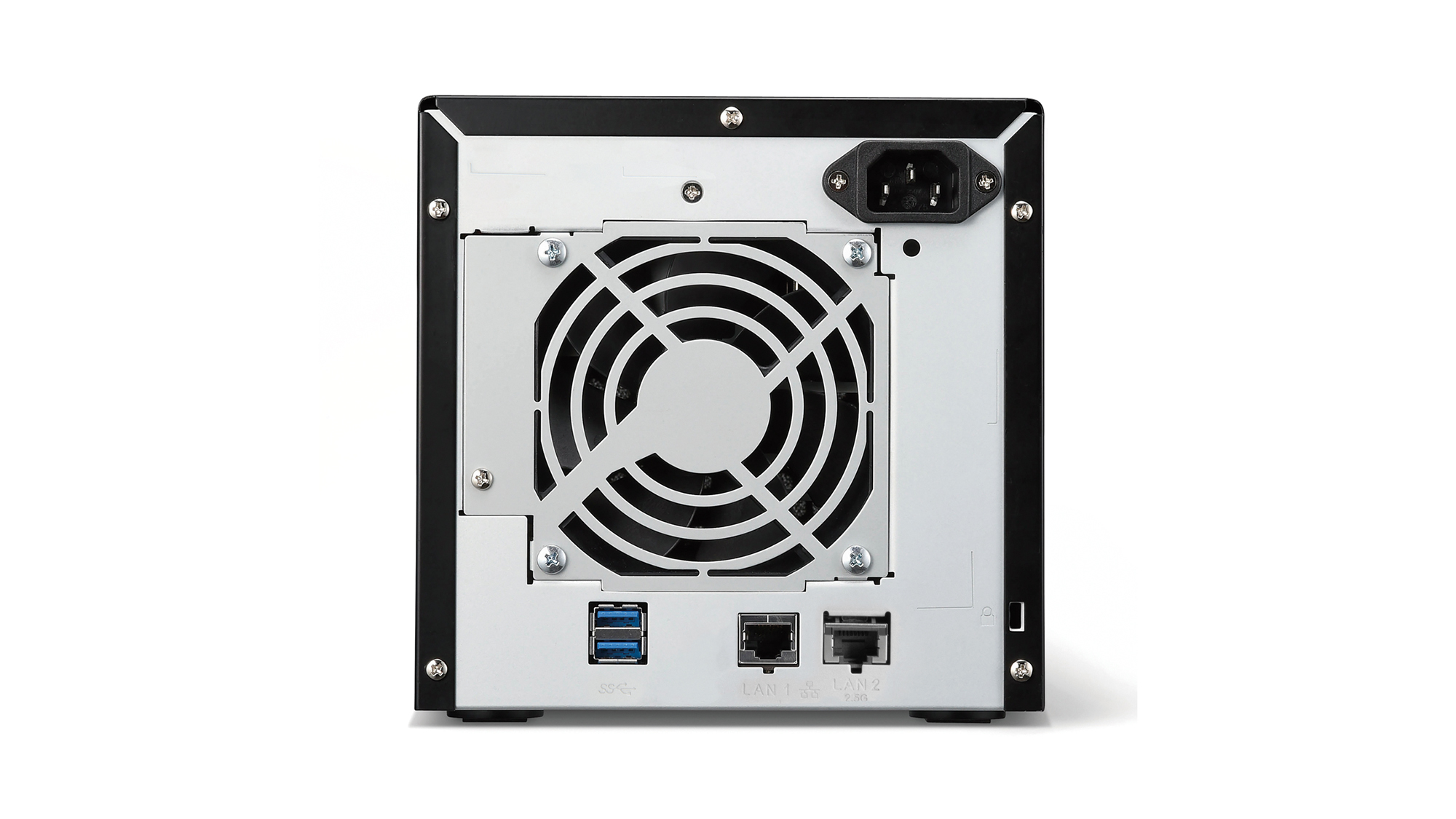Back up your files with these top NAS drives
A NAS is the one box every home and business should have. We put nine flexible devices through their paces to find a winner


While certain NAS devices try to straddle the business and enthusiast markets, Buffalo’s TeraStation line is focused wholly on the enterprise. The TS-3220 we’re looking at here is a case in point. Not only does it look more at home in a server room than the average living room, but it’s pared-back feature set is almost entirely focused on core business storage and backup tasks.
That’s also reflected in the design and construction. Standing 17cm tall with a 170 x 230mm desktop footprint, the TS-3220 is as big as some four-bay NAS devices, even though it’s a two-bay model. The two drives sit securely inside the rugged-looking chassis in slide-out caddies, where they’re firmly secured behind a lockable door. The unit has its own internal power supply, and this, the drives and processor are cooled by a whopping 92mm fan. This helps make it one of the noisiest NASes around, although it’s only at its worst when it’s first turned on and settles down to a sufferable background hum.
Buffalo sells the TS-3220 in 2TB, 4TB and 8TB configurations, with Seagate IronWolf drives preinstalled and ready to go. Should you need more capacity, four-bay desktop and rack-mounted versions are available. It’s a shame that you can’t upgrade the installed 1GB of DDR3 RAM, but there’s some compensation in the three-year warranty, and in Buffalo’s promise to replace defective disks within 24 hours if your order hits the system before noon.
Connectivity is where things start to get interesting. As well as two USB 3 ports for attaching external drives, the TS-3220 has one Gigabit Ethernet port and one 2.5GbE port. This makes sense for a business NAS because you’re more likely to see 2.5GbE networks in the office than in the home, and it also gives you the option of link aggregation for improved performance or for failover, should one network connection break down.
With the unit preconfigured, the wizard-based setup is relatively easy even if Buffalo’s NAS Navigator tool is about as utilitarian as utilities get. It’s a similar story with the browser-based management interface, but while it’s not exactly user-friendly, it is straightforward and efficient. It puts all of the options for managing storage, users, shared folders and backup as close as possible to the homescreen, and gives you the most critical information in at-a-glance dashboards. Whether you’re looking for a NAS server for file-sharing and collaboration or as a storage space for virtual machines, anyone who is technically proficient won’t have any trouble getting the TeraStation 3220 ready for its role.

The downside of this approach is that it’s not the most versatile NAS. Third-party apps are virtually non-existent, and features such as cloud backup are delivered through the browser-based interface. There’s no DLNA media server functionality, let alone the advanced virtualisation or software development features of other NASes. The TS-3220 is designed to do a few things really well and if that limits its uses, so be it.
Perhaps that’s why, despite an underwhelming specification, the TeraStation is a reasonably speedy device. On paper, the dual-core Annapurna ARM processor and 1GB of RAM look weedy, but the TS-3220’s sequential read speeds weren’t far behind those of the fastest NAS, while sequential write speeds are stellar. In our backup tests, which rely as much on processor as storage throughput, the TS-3220 starts to slip behind the pack – falling further behind while simultaneously streaming video – yet it’s still ahead of the other ARM-based units. Use this NAS for what it’s designed for and you won’t find it slow at all.
Get the ITPro daily newsletter
Sign up today and you will receive a free copy of our Future Focus 2025 report - the leading guidance on AI, cybersecurity and other IT challenges as per 700+ senior executives
Even bearing the preinstalled drives in mind, this isn’t what you might call a cheap NAS, and you can find comparable two-bay and even four-bay NAS for less. However, if your business relies on a NAS for storage and backup, the TS-3220 is the kind of NAS that gives you peace of mind. It might be big, loud and not so user-friendly, but it’s built to get the job done.
Buffalo TeraStation 3220 specifications
| Model number | TS3220DN0402-EU |
| Price (inc VAT) | £386 (£482) |
| Warranty | 3yr RTB |
| Dimensions (WDH) | 170 x 230 x 170mm |
| Noise level | Not stated |
| CPU | Annapurna AL-214 |
| CPU cores | Dual core |
| CPU speed, cores | 1.4GHz |
| RAM/maximum RAM | 1GB |
| Bays (free) | 2 (0) |
| Drive type | 1TB to 4TB 3.5in NAS hard disk |
| Max internal capacity | 8TB |
| RAID modes | JBOD, 0, 1 |
| Bay type | Slide-in caddy |
| Hot swap? | Yes |
| 2.5in drives supported | No |
| SSD support | No |
| Status display | 5 x status LEDs |
| Gigabit Ethernet ports | 1 |
| 10GB Ethernet ports | 2.5GbE |
| USB ports (rear) | 2 x USB 3 |
| USB ports (front) | No |
| Other | no |
| 802.3ad link aggregation | Yes |
| Load balancing | Yes |
| Network failover | Yes |
| Major network protocols | SMB, AFP, FTP, SFTP, NFS, RSYNC |
| iSCSI target | Yes |
| USB expansion options | Yes |
| NAS OS/firmware | Not stated |
| Main desktop software | NAS Navigator, Bsync |
| Remote access | Bsync |
| Cloud integration | Cloud Storage, AWS, OneDrive, Dropbox Sync |
| Backup | Nova Backup |
| Media | No |
| Surveillance | No |
| Testing and Development | No |
| Other major services | Antivirus |
Stuart has been writing about technology for over 25 years, focusing on PC hardware, enterprise technology, education tech, cloud services and video games. Along the way he’s worked extensively with Windows, MacOS, Linux, Android and Chrome OS devices, and tested everything from laptops to laser printers, graphics cards to gaming headsets.
He’s then written about all this stuff – and more – for outlets, including PC Pro, IT Pro, Expert Reviews and The Sunday Times. He’s also written and edited books on Windows, video games and Scratch programming for younger coders. When he’s not fiddling with tech or playing games, you’ll find him working in the garden, walking, reading or watching films.
You can follow Stuart on Twitter at @SATAndrews.
-
 Cisco names Oliver Tuszik as global sales chief
Cisco names Oliver Tuszik as global sales chiefNews Cisco has announced the appointment of Oliver Tuszik as its new executive vice president of global sales, who replaces Gary Steele.
By Daniel Todd
-
 AI will chew through the same amount of energy as Japan by 2030
AI will chew through the same amount of energy as Japan by 2030News The energy demand of AI data centers will top that of Japan by the end of the decade, new research shows – and that’s providing that energy grids can even keep up.
By Nicole Kobie